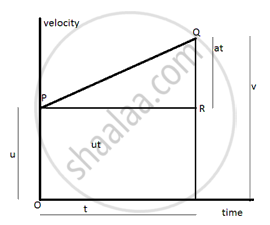Advertisements
Advertisements
प्रश्न
Derive th e equation of motion.
S = ut+ `1/2` at2,
Where the symbols have their usual meanings
उत्तर

In figure we know
S = area of trapezium OSQP
Area of trapezium OSQP = 1/2 (sum of parallel sides) x perpendicular distance between them.
S = 1/2 (OP + SQ) x PR.
PR= QR/a= (QS-RS) / a
PR= (v - u)/a = t
So PR= t .
Substituting these values in expression of area of trapezium we get
S= 1/2 (u + v) xt
S = 1/2 (u +v) x (u - v)/a.
2aS = v2 - u2
v2 - u2 = 2 as.
This is known as third equation of motion.
APPEARS IN
संबंधित प्रश्न
What is the Differnece between speed and velocity ?
During an experiment, a signal from a spaceship reached the ground station in five minutes. What was the distance of the spaceship from the ground station? The signal travels at the speed of light, that is, 3 × 108m s−1.
Arrange the following speed in increasing order (keeping the least speed first):
An athlete running with a speed of 10 m/s.
If a sprinter runs a distance of 100 metres in 9.83 seconds, calculate his average speed in km/h.
A train travels the first 15 km at a uniform speed of 30 km/h; the next 75 km at a uniform speed of 50 km/h; and the last 10 km at a uniform speed of 20 km/h. Calculate the average speed for the entire train journey.
A ball hits a wall horizontally at 6.0 m s-1. It rebounds horizontally at 4.4 m s-1. The ball is in contact with the wall for 0.040 s. What is the acceleration of the ball ?
Express 15 m s-1 in km h-1.
Define average velocity and give one example.
Distinguish between speed and velocity.
Which of the following figures (Fig. 8.3) represents uniform motion of a moving object correctly?
